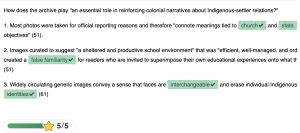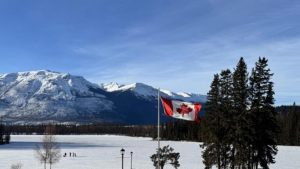4
These are difficult stories. We bear witness in this chapter to the role of sport in furthering the settler colonial projects throughout Turtle Island. Here are some supports to access in the community and from a distance:
First Peoples House of Learning Cultural Support & Counselling
Niijkiwendidaa Anishnaabekwag Services Circle (Counselling & Healing Services for Indigenous Women & their Families) – 1-800-663-2696
Nogojiwanong Friendship Centre (705) 775-0387
Peterborough Community Counselling Resource Centre: (705) 742-4258
Hope for Wellness – Indigenous help line (online chat also available) – 1-855-242-3310
LGBT Youthline: askus@youthline.ca or text (647)694-4275
National Indian Residential School Crisis Line – 1-866-925-4419
Talk4Healing (a culturally-grounded helpline for Indigenous women):1-855-5544-HEAL
Section One: History
A) The Residential School System
Exercise 1: Notebook Prompt
We are asked to honour these stories with open hearts and open minds.
Which part of the chapter stood out to you? What were your feelings as you read it? (50 words)
| While reading the chapter, I was shocked to learn that their participation in sports and recreational activities was not for their own enjoyment or health, but another tactic used to erase their Indigenous culture. Over the years, I have educated myself on the history of residential schools, but I did not know about this. These sports were used to erase their memory of the activities that they knew and grew up with. I genuinely can not believe the lengths that they took to erase their culture. This chapter made me reflect on what I presumed about sports, and something as simple as a leisure activity was used in such a negative way.
|
B) Keywords
Exercise 2: Notebook Prompt
Briefly define (point form is fine) one of the keywords in the padlet (may be one that you added yourself).
| The Indian Act is a law that was passed in 1876. This law allowed full control from the government over the lives of Indigenous people. The goal of this law was to completely erase Indigenous identity to fit into Canadian norms. The law took control of cultural practices and ceremonies and, overall, their freedom. Over the years, the Indian Act has been altered; the law is still in place as of today, still controlling their rights.
|
C) Settler Colonialism
Exercise 3: Complete the Activities


Exercise 4: Notebook Prompt
Although we have discussed in this module how the colonial project sought to suppress Indigenous cultures, it is important to note that it also appropriates and adapts Indigenous cultures and “body movement practices” (75) as part of a larger endeavour to “make settlers Indigenous” (75).
What does this look like? (write 2 or 3 sentences)
| The term ‘cultural appropriation’ means someone, or a group, taking aspects of a culture’s identity, such as hairstyle, traditional clothing, movement, etc., and making it their own without the understanding or respect of its origin.
I believe that is what the colonial project is doing as well, where Indigenous cultures “body movement practices” are now used everywhere but are still frowned upon by some people. In simple words, as long as these movements, such as yoga, belly dancing, or even hip-hop dancing, are for their entertainment, who cares where they started? There are aspects, things, such as yoga, where someone who may support this colonial project and also enjoy yoga would never believe that yoga is a part of the Indigenous culture. It is so important to understand the history behind the things we enjoy so we can offer our respect and understanding for history. |
D) The Colonial Archive
Exercise 5: Complete the Activities

Section Two: Reconciliation
A) Reconciliation?
Exercise 6: Activity and Notebook Prompt
Visit the story called “The Skate” for an in-depth exploration of sport in the residential school system. At the bottom of the page you will see four questions to which you may respond by tweet, facebook message, or email:
How much freedom did you have to play as a child?
What values do we learn from different sports and games?
When residential staff took photos, what impression did they try to create?
Answer one of these questions (drawing on what you have learned in section one of this module or prior reading) and record it in your Notebook.
| The staff at the residential schools wanted to make the impression that these schools were full of support and children who did want to attend were having fun. That these schools helped their own well-being. To do so, they would take posed or not-candid photos of the children smiling and laughing to create this illusion.
The maltreatment and cultural oppression were masked by these images. The pictures versus the true reality of the kids took away from their loss. It made the schools look like a positive place so the colonial project would look better, but this just was not the case. |
B) Redefining Sport
B) Sport as Medicine
Exercise 7: Notebook Prompt
Make note of the many ways sport is considered medicine by the people interviewed in this video.
Sport serves as a form of medicine because
|
C) Sport For development
Exercise 7: Notebook Prompt
What does Waneek Horn-Miller mean when she says that the government is “trying but still approaching Indigenous sport development in a very colonial way”?
| When Waneek Horn-Miller means when she says that the government is “trying but still approaching Indigenous sport development in a very colonial way,” she is pointing out that this strategy still reflects the colonial project, even if Indigenous sports are receiving funding. The government pushes programs that are influenced by Western ideals and places expectations on Indigenous communities rather than them being able to work on their own goals and initiatives. Without acknowledging or promoting traditional Indigenous games, rites, and cultural values associated with movement, these programs will just come to assume that the mainstream sports we know of will be the best to help promote health or unity. |
Exercise 8: Padlet Prompt
Add an image or brief comment reflecting some of “binding cultural symbols that constitute Canadian hockey discourse in Canada.” Record your responses in your Notebook as well.
|
This is an image of a lake in Canada with a Canadian flag. In the winters, it is a sign of Canadian symbolism to play hockey on ponds/lakes; it truly represents the Canadian culture. At the same time, it also hides the fact that Indigenous kids were forced to play games such as hockey instead of their own traditional games. People often forget, or were never aware of how hockey was to help erase Indigenous culture.
|
Section Three: Decolonization
Please see the major assignment for this half of the term in the final section of this chapter.



